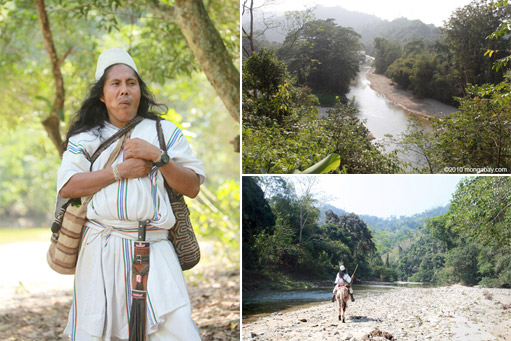Researchers have found that coca cultivation is associated with high rates of forest loss, at least in the southern forests of Colombia. According to a new paper just published in Environmental Science and Technology, areas near new coca plots are significantly more likely to suffer from forest loss. Politicians, environmental groups, and others have long attributed deforestation to coca production. But these researchers are the first to quantity the effect of coca cultivation while controlling for other factors.
Colombia is the world’s second largest producer of coca, the raw material for cocaine, after Peru. It also suffers from deforestation; in southern Colombia, for instance, which includes both the northern Andes and parts of the Chocó forest, forest cover fell from 82% to 78% between 2002 and 2007.
In comments to Chemical & Engineering News, the lead author, Liliana Daválos, said that coca cultivation was at least as damaging to the forests of southern Colombia as “all the other factors combined—and I mean mining, oil drilling, logging, cattle ranching, biofuels, and food crops”.
 Danilo Villafañé, an Arhuaco indigenous leader in Sierra Nevada de Santa Marta who is helping his people take back lands formerly controlled by guerrillas and cultivated by commercial coca growers. Photos by Rhett A. Butler 2010. |
The coca farms themselves are small, and the researchers say that in all of Colombia, land cleared for new coca farms accounted for only about 89,000 hectares between 2002 and 2007. It seems that some of those plots were eventually abandoned; as of April 2010, coca fields covered only about 68,000 hectares in Colombia But the researchers suggest that coca production may have affected the forest in other ways. Armed conflict linked to coca production may have forced farmers to relocate to new fields, triggering deforestation. Large profits may have encouraged migration into the areas where coca is grown. Efforts to eradicate coca by spraying herbicide may have damaged or destroyed forest.
Above all, though, their results suggest that coca production is really a proxy for other drivers of deforestation, especially population growth in poor, undeveloped areas. They found that coca is usually produced in villages at the very edge of the undeveloped forest, at the frontier where settlement meets the wilderness. There, coca production is a symptom of various underlying problems, including poverty, underdevelopment, and population growth.
Notably, the researchers also found that in most cases, land with protected status (land within nature reserves, biospheres, and sanctuaries) was significantly less likely to undergo deforestation, especially in central and southern Colombia. Although some coca is definitely being grown in national parks, coca farmers and others generally tend to avoid the protected areas. Dávalos said that this was probably because coca growers, like other Colombian farmers, are usually hoping to gain title to the land they occupy. The growers recognize that in protected areas, this is less likely to occur.
Citation: Forests and Drugs: Coca Cultivation in Biodiversity Hotspots. Liliana M. Davalos, Adriana C. Bejarano, Mark A. Hall, H. Leonardo Correa, Angelique Corthals, Oscar J. Espejo. Environ. Sci. Technol, January 11, 2011.
Related articles